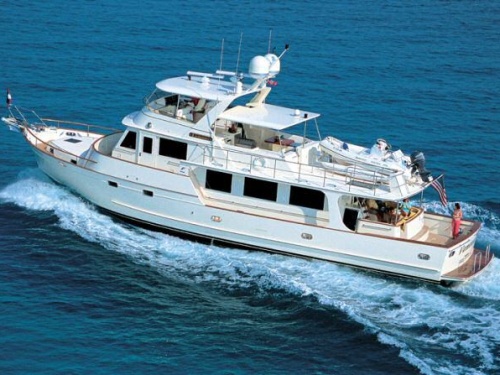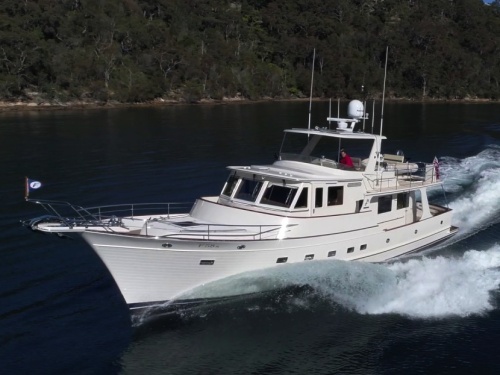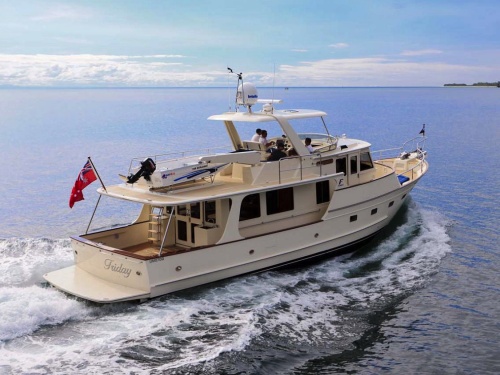Access More Boat Tests
Already have an account? Login
Fleming Yachts 65 (2014-)
Brief Summary
The Fleming 65 is an ocean-capable, offshore-proven yacht designed to make long passages at displacement speeds while retaining the ability to pick up to planing speed when time dictates.
Fleming includes, much as standard equipment, far greater critical systems redundancy than nearly all coastal motoryachts, and the Fleming 65 surpasses standard backups aboard many expedition yachts as well.
A raised pilothouse, Portuguese bridge and protected side decks provide salty looks and safety offshore, while the large galley and open living areas create spaces that seem more like a vacation home than a cruising boat.
Several accommodations plans -- including an optional full-beam master suite -- allow this globe-traveling three stateroom home to be tailored to owners’ individual needs.
Key Features
- Raised pilothouse provides visibility at sea and keeps weight low
- Flying bridge offers topside driving and outdoor dining when weather permits
- Walk-around side decks and Portuguese bridge have high bulwarks for safety
- Large cockpit rivals the square footage of many sport fishers
- Optional aft deck outdoor dining that seats eight
- Six accommodations plans include a full-beam master plus VIP suit and bunk-bed cabin
- 2000 nautical mile range at 8 knots from 1700 gallons of onboard fuel (with reserve)
- 1400 mile range at 9 knots (with reserve)
- 500 nautical mile range at planing speed
- Robust systems, rugged hardware and handrails throughout the boat
- Refrigerator, deep freeze and pantry space also suit long cruises
- Backups of most critical systems and even tertiary steering control
Specifications
| Length Overall | 65' / 19.8 m |
|---|---|
| Beam |
18' 8'' 5.70 m |
| Dry Weight |
102,698 lbs. 46,583 kg |
| Draft |
5' 1.52 m |
| Deadrise/Transom | N/A |
| Max Headroom |
6' 6'' 1.97 m |
| Bridge Clearance | N/A |
| Fuel Capacity |
1,700 gal. 6,435 L |
| Water Capacity |
400 gal. 1,514 L |
Engine Options
| Tested Engine |
Currently no test numbers. |
|---|---|
| Std. Power |
2 x 800-hp MAN R6-800 CRM |
| Opt. Power |
2 x 1000-hp MAN V10-1100 RPM 2 x 405-hp Cummins QSL9 6-cylinder |
 Learn More
Learn More
Watch Our Video

Mission of the Fleming 65
Offshore Passages.
Like all Fleming models, the mission of the 65 is pretty straightforward -- provide safe, comfortable passage across large swatches of ocean, and carry along infrastructure needed to enjoy remote destinations.
Overview
Ultimate Owner-Operated Cruiser.
The 65 was introduced in 2005 to provide more elbow room than the company’s long-popular 55 foot offshore cruiser, but be not so big as to require crew, as is intended (but not necessarily required) aboard the company’s 75 (now 78) footer.
Yet this 65 gives up surprisingly little in accommodations to the 78 -- notably the 78 separates the dining area from the salon, and the 78 includes a covered outdoor aft deck separate from the cockpit as well as a crew stateroom beneath the aft deck.
Accommodations on both models include three staterooms and two or three heads forward, plus a day head in the pilothouse.
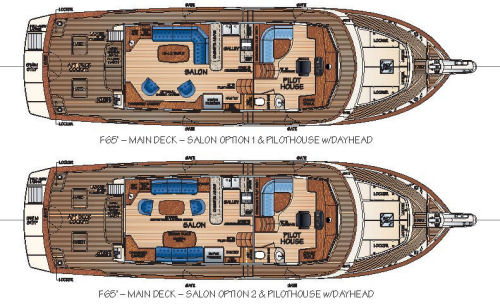
Space is Premium.
While it’s a bit counterintuitive, the last place to have to rough it is in the middle of an ocean. Three weeks underway from Fort Lauderdale to the Mediterranean is not the time to be cooped up in tight staterooms, cooking in an abbreviated galley, or cramped into a diminutive dinette.
And those few weeks of crossing can turn into months of cruising. What might be livable for a coastal motoryacht used on long weekends can become claustrophobic by the end of an entire summer aboard.
Fleming uses space aboard to provide comfortable, private retreats.

Live Aboard.
Those large, private spaces also benefit coastal cruisers and liveaboards.

Distinguishing Features
Economical Travel.
When shuffling north and south with the seasons or poking along U.S. cruising routes, boats designed to travel 2000 miles between fuel docks offer another advantage to coastal cruisers -- lower cruising cost.
The Fleming 65 running at 8 knots should burn less than 1000 gallons of diesel over the 1100 nautical miles from Sag Harbor to South Beach. At 18 knots most 65 footers will burn roughly four times that much.
A trip through the Abacos or Exumas might take in a few more stops and be a few days longer at 9 knots, but full tanks at cheaper prices (relatively) in Florida will last the whole cruise. (And there will be less of a concern about contaminated fuel.)
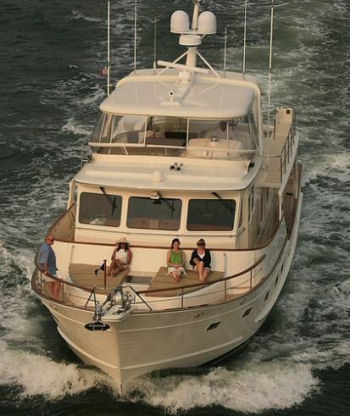
Different Motion and Different Pace.
Since the Fleming 65 is designed for displacement travel -- not relying on hull surfaces and stabilizers interacting with water at planing speed for stability -- the boat’s slower response to the motion of the sea and leisurely pace along a route both tend to make passages more relaxing.
Fast When Desired.
Yet unlike many expedition yachts, which cannot exceed their displacement speed, the Fleming 65 can throttle up to 16 knots with the standard 800-hp MAN diesels or 18 knots from the optional 1000 horsepower MANs. (For this reason, Fleming calls their boats “pilothouse motoryachts”.)
When a long weekend is all the time available, the fuel penalty for quicker miles pays off by adding playtime.
Redundant Systems.
From dual freshwater pumps to multiple backup steering systems meet their boats’ ocean crossing, remote port mission. But redundancy benefits anyone wishing not to interrupt a cruise if an important system fails.
For long-distance or coastal cruisers who believe Murphy’s law is optimistic (whatever can go wrong will, at the worst possible moment), Fleming’s backup systems are comforting.
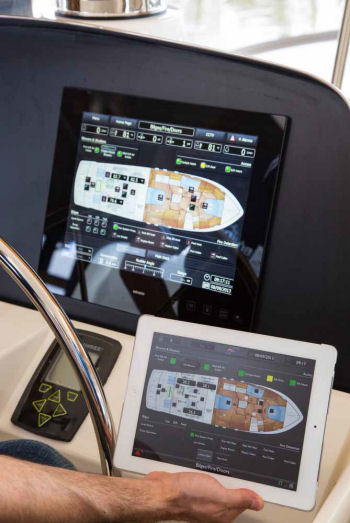
The Standard Equipment list
includes most gear needed for distance cruising from the 1500-lb. tender davit to a 7000-watt inverter system.
The Optional Equipment list
includes just about everything else that one might add before departing, including a 980-watt solar charging system atop the hardtop, a second, 80-lb. anchor with 300’ of chain lifted by a second windlass, and three options for wine coolers.
Tony Fleming’s experience and vision
is in every Fleming -- particularly the 65.
His own cruising grounds have ranged from the South China Sea to the Virgin Islands and from the Baltic Sea to the Galapagos, including 45,000 miles on the first Fleming 65 built, “Venture,” and another 10,000 miles on his second 65, “Venture II.”
Tony Fleming’s cruising experience, as well as the input from his boat’s captain, Chris Conklin, resulted in hundreds of design tweaks to the 65 and all models over the years.
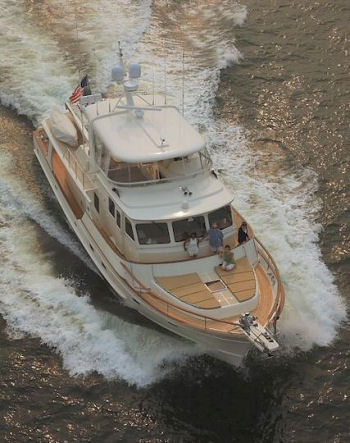
Two Distinct Philosophies
Expedition yachts fall into two categories--
True displacement yachts
, often driven by a single engine, are particularly fuel efficient. Since they never have to plane (nor can they), some include ballast like a sailboat.
Semi-displacement
cruising yachts, like all Fleming models, are designed to be more efficient at displacement speed than most similarly sized yachts, yet they retain twin engines with enough horsepower and planing surface to run fast.
Handling Nasty Weather or Avoiding It.
As for weather at sea, given adequate fuel on board, added speed can move a semi-displacement boat 100 miles in a few hours -- away from the worst of a storm’s track. Nowadays satellite communication and private weather services like Weather Routing (wriwx.com) leave the determination of where to best position the boat in the hands of true experts.
And if caught in nasty weather, the Fleming 65 meets the stringent stability requirements for European CE Class A (Oceans) rating.
Propulsion
Machinery spaces are designed for owner-performed maintenance, even at sea. (2000 miles from California to Hawaii adds about 250 hours to engines.)
Noticeably different horsepower options
include adequate propulsion, an upgrade for more speed, and an option for much smaller engines that push the boat only to the upper edge of displacement speed.
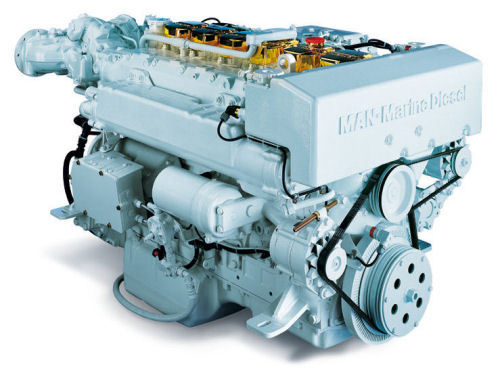
Standard MAN R6-800
6-cylinder 800-hp diesels allow the Fleming 65 to cruise around 16.5 knots, according to Fleming, as we have not tested the boat.
Optional MAN V8-1000
8-cylinder 1000-hp engines cruise around 18 knots, also according to Fleming.
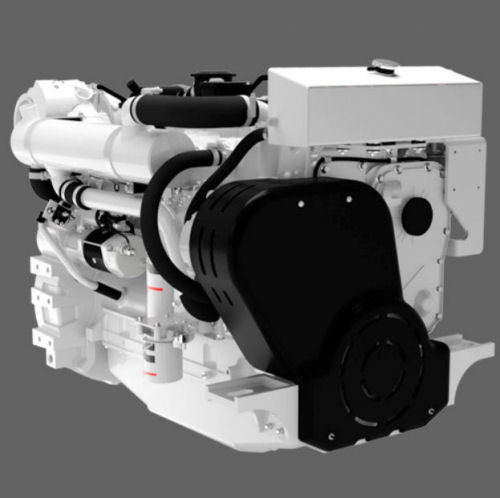
Optional Cummins QSL9
6-cylinder 405-hp (commercial rated) engines limit the boat to displacement speed but offer reduced maintenance costs, and save about $165,000 off the purchase price. (Bear in mind, however, that eliminating the boat’s ability to run fast may impact resale.)
Fuel burned per mile traveled
won’t change much at displacement speed with any of the three engines. Planing speed economy between 800 hp and 1000-hp offerings should be similar for a given speed as well.
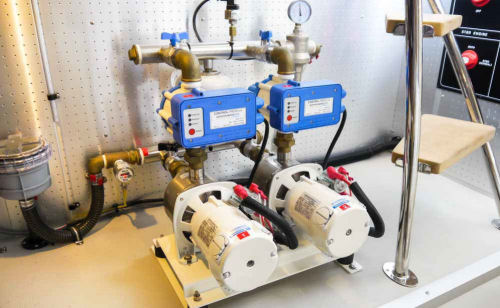
Expedition-Suited Systems
Whether 10,000 miles or 10 miles from home, time enjoying a cruise is lost whenever a critical system fails. Coastal cruisers can simply pull into port (or be towed) and await a mechanic. Distance cruisers might wait days for a repairman and a week for parts, so Fleming’s redundancy extends beyond just safety.
Steering Redundancy.
Fly-by-wire steering uses fewer mechanical parts, and those parts are isolated to the lazarette. Electrical components are redundant, with individual input from the pilothouse and flybridge steering wheels connected to individual inputs that control the primary steering pump in the lazarette.
To reduce wear, Fleming’s pump only runs when the wheel is turned. When the steering ram reaches the end of its travel, a pressure switch triggers magnetically operated shaft brakes on the helm units, so that the operator knows the steering is hard-over by feel.
If both helm units, or the primary pump, or its power supply fail, pressing a back-up steering push-button in the pilothouse disconnects power to the primary pump and helm units and powers up the back-up system with its own pump, control circuit and incoming electrical feeds, powered from a different battery bank than the primary pump. A port/starboard toggle switch in the pilothouse operates the rudder.
Should the back-up steering system fail, the boat can be steered with the autopilot, which has a dedicated third pump.
If all else fails, an override button bypasses all electronics to allow the steering pump to run continuously. Manually operating the port or starboard solenoid valves in the lazarette moves the rudders.
That leaves steering rams, hydraulic hoses and hydraulic solenoids as the only parts in common. A steering ram seal kit, a single 4-foot spare hose, and a solenoid or two should cover any foreseeable emergency repairs.
Of course, twin-engine boats, with rudders centered, can be steered with throttles alone.
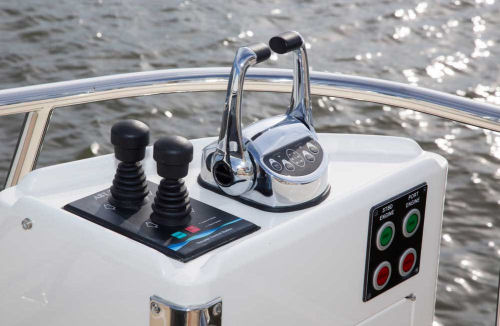
Shift and Throttle
Glendinning engine controls include two sets of switches and potentiometers for every function. Pressing the backup control button employs those secondary switches, as well as a redundant processor with its own power supply and a dedicated CAN Bus cable.
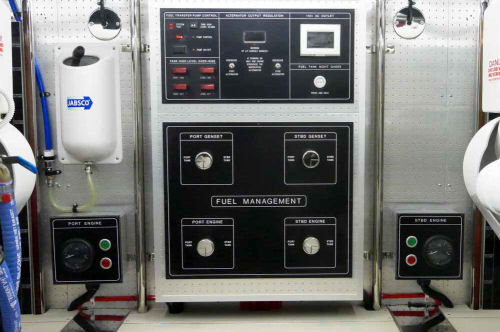
Fuel Systems.
Four fuel tanks are fitted with sight glasses in addition to fuel levels displayed in Fleming’s Central Monitoring System.
A pump transfers fuel at 22 gallons per minute from any tank to any tank while counting the gallons transferred. Switches in tanks trigger an alarm and switch off the transfer pump when tanks are full. All engines and generators draw from either port or starboard tanks, and interconnecting pipes with isolation valves also allow gravity transfer.
An optional fuel polisher stirs tank bottoms and filters out sediment, drawing fuel from the bottom of any tank and returning it to the top of the same tank or to another tank.
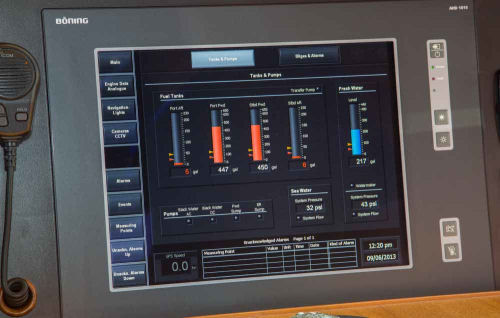
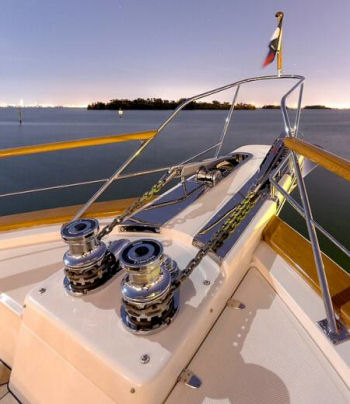
Ocean-crossing Construction Considerations
Fleming uses long-proven construction techniques and running gear, modified a bit to allow for the perils of offshore cruising.
Impact resistance
comes from the solid laminate hull, significantly thicker below the waterline and reinforced with interlocking frames and full-length box-section stringers. Additional fiberglass further strengthens the hull at the stem and in the bow ahead of the collision bulkhead, at the stabilizers and along the chines and keel.
A stainless steel shoe protects the aft 8’ of the keel.
The deck and superstructure are Corecell cored to reduce weight aloft and lower the center of gravity for greater stability.
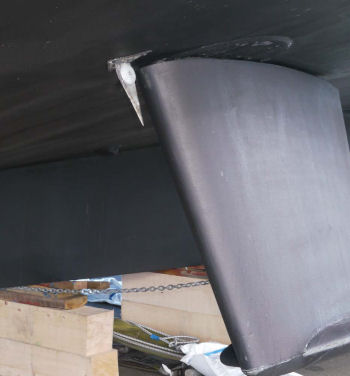
Entanglement
in fishing nets, towing hawsers or the like is hopefully prevented with blades just ahead of each stabilizer and a Quick Kutter rope cutting blade system attached to propeller shafts and struts.
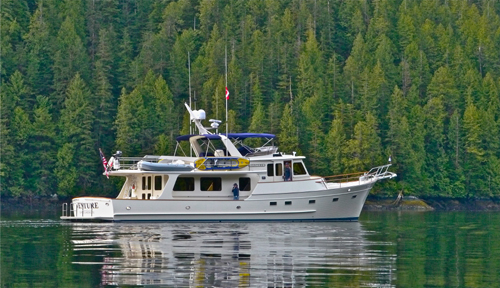
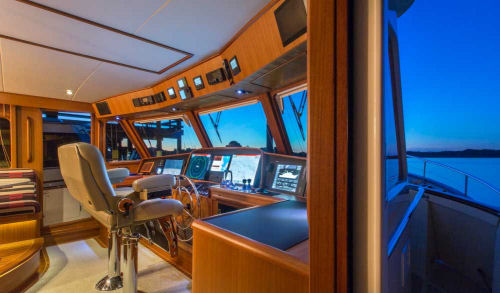
Command Center
Most systems aboard are controlled from one of three places -- the pilothouse, at the entranceway to the lazarette and engine room, or on the forward engine bulkhead. Depending on electronics installed, navigation is duplicated between the pilothouse and flying bridge.

The pilothouse
provides excellent visibility forward and to the sides. A few quick steps up to the bridge or down to the salon, or a peek out either pilothouse door offer visibility aft.
The helm
provides lots of room, depending on how electronics are installed, to allow two or three people to be actively involved in steering, charting and radar plotting in busy shipping or tricky navigation areas.
Extra-thick tempered glass and stout windshield wipers with freshwater wash shield the watch crew from whatever mother nature throws up.
The chart table
includes four chart-width drawers mounted on full-extension slides. With the full-beam master, however, the steps down to forward accommodations replace the chart table. (Otherwise steps directly from the galley lead to accommodations.)
The day head
on the starboard side, aft of the pilothouse door, allows the on-watch crew quick relief.
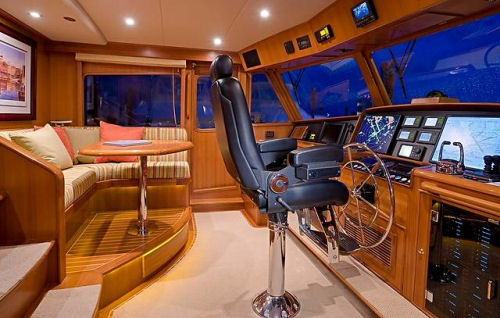
The pilothouse settee
provides an area for the on-watch crew to relax, and the table lowers into a wide berth. This allows crew on watch and another immediately available but resting while additional crew sleep below, off watch.
Since forward staterooms enter the galley directly, the pilothouse remains private for sleeping at the dock. (Except, as noted, accommodations are entered from the pilothouse.) Optional privacy doors further separate the pilothouse for sleeping.
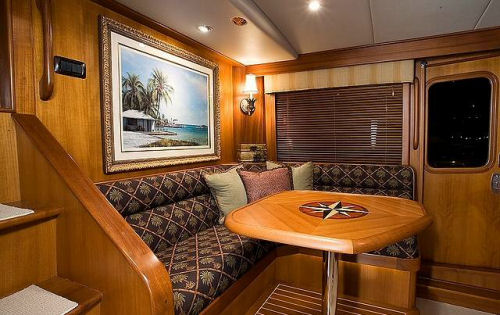
An optional Pullman berth or pipe-and-canvas berth above the settee enhances sleeping accommodations underway or turns the pilothouse into perhaps the ultimate kids’ stateroom.

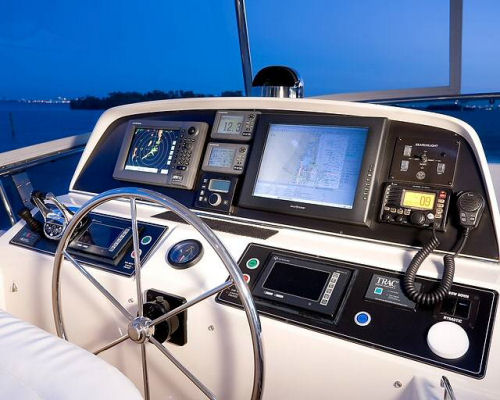
The flying bridge helm
is just four steps up from the pilothouse and offers plenty of space on the dash for fully redundant electronics, making it easy to pop up top for tricky channels or run the boat from the bridge and quickly switch to the pilothouse when weather warrants.

The flying bridge
includes a large dinette with storage beneath the seats and within the table pedestal. A refrigerator, wet bar, chest freezer and grill extend down the port side.
The boat deck
includes a ladder to the aft deck on the port side, aft of the hardtop. The standard 1500-lb. davit includes hydraulic cable lift, boom lift, boom extension and rotation, powered by a self-contained 24-volt DC hydraulic system.
Open space to starboard accommodates a 16’ tender well-suited to exploring, diving and fishing beyond where the big boat might reach.

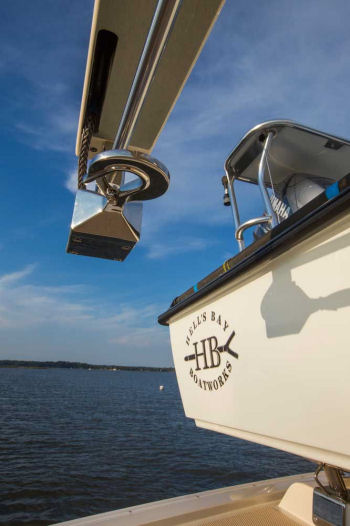
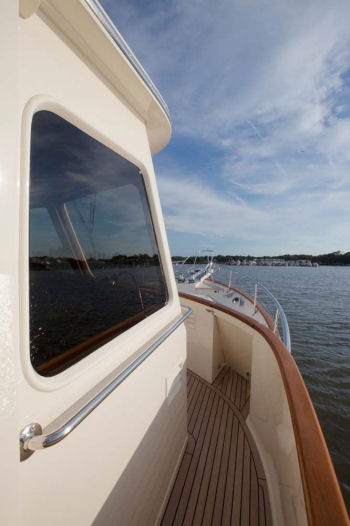
Portuguese Bridge, Bow and Side Decks
The Portuguese bridge, along with side deck and transom bulwarks provide secure passage all the way around the boat.
Portuguese Bridge
makes a protected spot to get outside directly from the pilothouse for fresh air or a clear view. The bulwark across the bow also helps protect the pilothouse windows if the bow dips into a wave.
Port and starboard doors
in the bulwark allow passage to the bow. Handrails attached to the front of the Portuguese bridge bulwark extend along the top of the trunk cabin to the bow, in addition to the teak (or optional stainless steel) handrails and stanchions outboard.
The trunk cabin top provides seating, and storage lockers within the trunk cabin are vented to help prevent mildew.

Anchoring.
Fleming offers several choices for anchor handling. Standard is a single 24-volt DC windlass with two chain gypsies and a rope capstan. Most boats opt for dual hydraulic windlasses instead.
(Bow and stern thrusters are similarly either electric or hydraulic.)
Whichever option is chosen, anchors can be raised and lowered from the bow, from the pilothouse or from the flying bridge. Chain counters at each helm are options, and we recommend them for night work when marks on the chain are hard to see.
The standard 132-lb. anchor is fitted with 300’ of high-test chain. The second anchor is typically 80 lbs. with either 100’ or 300’ of chain.
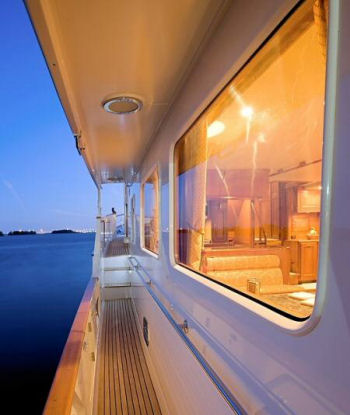
Side Decks.
Side decks continue the protected path from the Portuguese bridge all the way to the cockpit. Doors in the bulwarks open for dockside boarding.
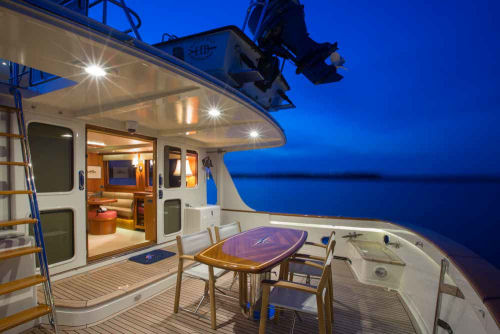
The large cockpit
is comparable to many sport fishing yachts. Add a bait well, outriggers and a fighting chair and this Fleming 65 could easily follow Zane Gray’s marlin and tuna exploits from Nova Scotia to Bimini, California and through the Pacific.
Seats with storage lockers aft can be fitted with warping capstans. Deck hatches access the voluminous lazarette directly.
The transom door leading to the swim platform can be fitted with a passarelle. Fleming offers optional folding cleats on the swim platform to tie off a tender. In addition to the hand rail secured across the transom, an optional removable railing aids boarding from the dock.
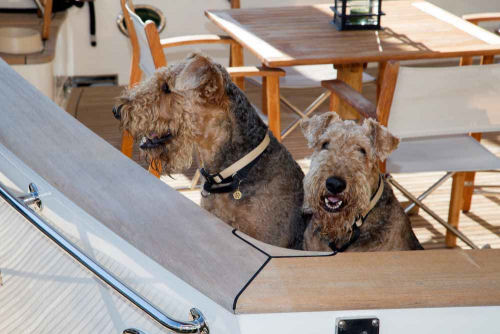
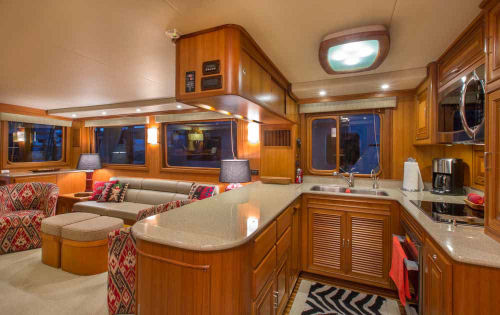
Life Underway
Comfortable spaces both for camaraderie and for private time are particularly important for distance and long-term cruisers.
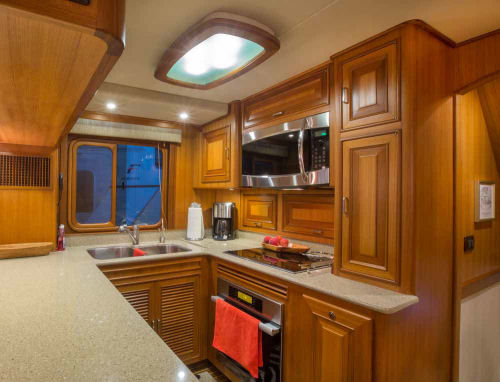
Galley
In the ten or twelve days from California to Hawaii, or any similar passage, daily routines tend to focus on food. The full-beam galley fills that need well. Snacks and coffee while underway are just four steps down from the pilothouse.
The galley’s main section to port
includes a large peninsula countertop for serving and food prep. Numerous drawers, some large enough for portable appliances, make particularly good use of the considerable cabinet space. The large double sink outboard is recessed beneath granite or Corian countertops, and the microwave, cooktop and optional oven are forward. The optional Slimline dishwasher fits to the left of the sink.
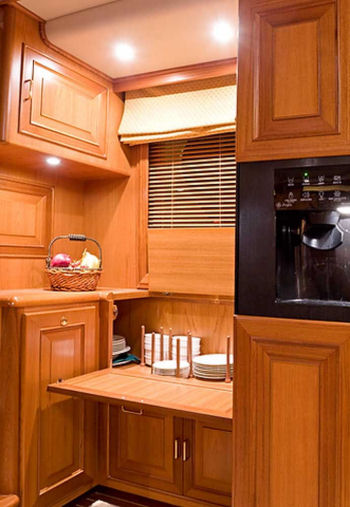
The starboard galley
includes a full-height, 20.5 cu. ft. side-by-side refrigerator/freezer and a butler's pantry with a dish locker and a slide-out food pantry, along with more counter space and extra storage. This is one of the best arrangements we have seen in class.
The induction-type four-burner cooktop
includes stainless steel rails to the right and behind with clamps for securing pots underway.
Inverter power
for both the microwave/convection oven and cooktop negate the need to run a generator to cook most meals.
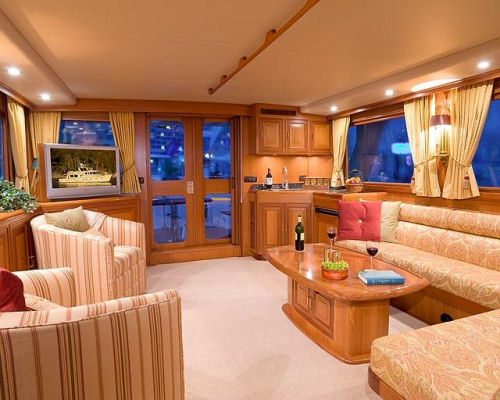
Salon
Large fixed salon windows and the wide double door aft open up the salon, avoiding the enclosed feel of some boat cabins, but Fleming’s teak joinery and satin-rubbed varnish retain a decidedly nautical flair.
Fleming offers considerable flexibility here for seating and dining configuration. The overhead teak handrail, teak valances and wooden window blinds are standard.

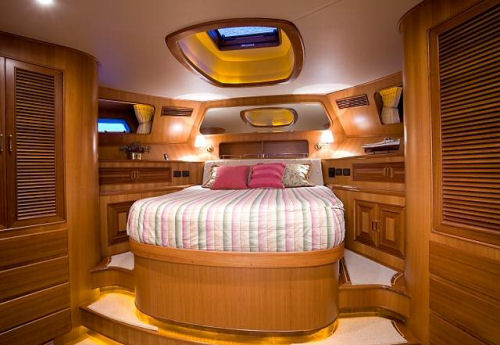
Accommodations Below
In all but the full-beam master layout, forward accommodations are entered down a flight of stairs directly from the salon, with a hallway passing between the port and starboard staterooms.
The forward stateroom
doesn’t change significantly in any of the five accommodations plan options of the Fleming 65. The majority of boats are built with this (see below) as the master suite, leaving the starboard head and shower private to this stateroom.
Twin hanging lockers and drawers outboard, as well as additional lockers, drawers and a vanity along the aft bulkhead, provide plenty of storage.
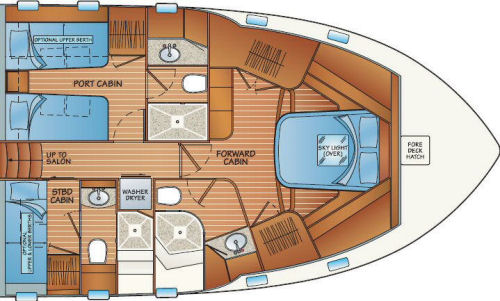

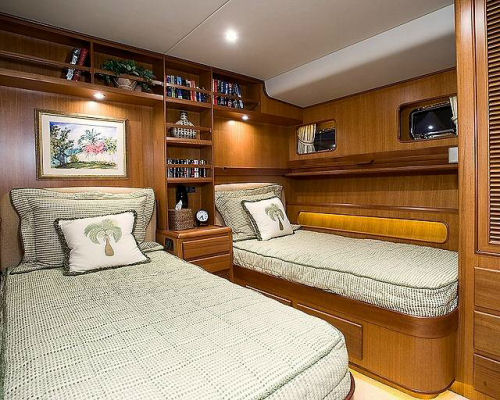
The port aft stateroom
can be fitted with twin beds or a queen bed outboard. The head is accessed en suite or from outside of the stateroom.
In the alternate master suite arrangement
the stateroom gets either an athwartship island queen bed pressed against the hull side, or a fore-and-aft queen bed against the aft bulkhead. Either way, the head becomes private and larger, encroaching a bit on the forward stateroom.
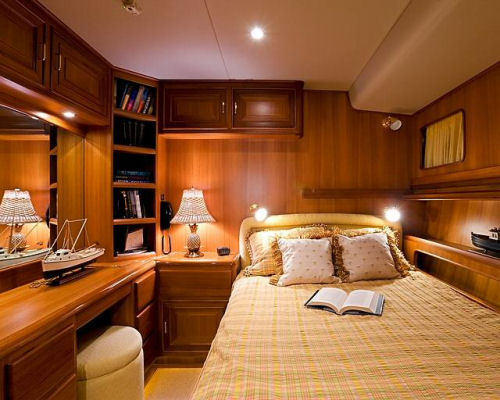

The starboard aft stateroom
includes L-shaped bunk beds with no head in the standard configuration. It can also gain a private head and shower along the forward bulkhead, with either a single berth or over/under bunks along the aft bulkhead.
Fleming also offers either a Pullman-type folding upper bunk or a pipe-and-canvas upper bunk.
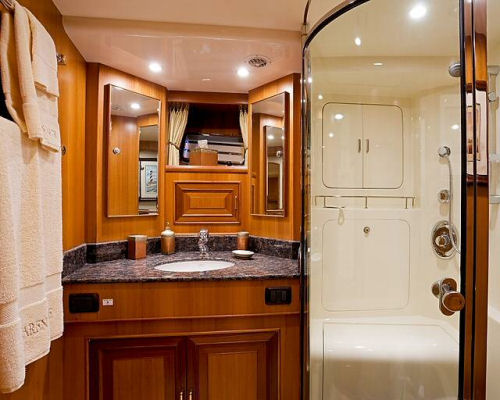
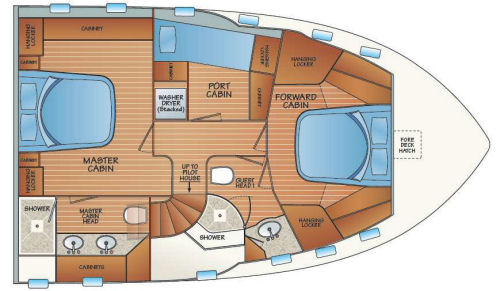
Full-beam master suite
aft is an intriguing option offering a considerably larger head outboard to starboard. While it gains the otherwise wasted space of a hallway, it shifts traffic through the pilothouse and down a curved stairway. This eliminates the chart table in the pilothouse and encroaches on the starboard guest shower. (The table at the settee can double as a chart table.)

Machinery Spaces
Fleming 65 divides machinery and equipment between the lazarette and engine room, both accessed from the cockpit. Engines, generators, fuel and lube systems, and batteries are within the engine space, while most ancillary equipment is aft in the lazarette.

The engine room
doesn’t offer standing headroom -- the drawback to keeping accommodations as low as possible for stability. But systems are straightforward and accessible for easy repair.
Fleming also offers optional air conditioning to cut humidity and make maintenance more pleasant in the tropics.
The lazarette
also offers only crouching headroom, but it is wide open with excellent access to all systems from the battery panel on the forward bulkhead to the steering gear and stern thruster at the transom.
Optional deck hatches in the cockpit add access, although they include no bin or compartment inside of the hatch -- they simply access the entire lazarette.

Engine Room Access
is a potential liability during offshore passages, since the engine room must be accessed through the aft deck.
While the 8’’ step should preclude water entering, if the boat drifts with the stern quartered into a large breaking sea, that might not be the case. On any ocean crossing on any boat, a sea anchor should be rigged and ready to keep the bow into the waves if engines die, negating the Fleming 65’s concern of water entering this hatch.
Of course, the advantage to entering the engine room from the aft deck is that it keeps mechanics and mess out of the salon.

Details of Electrical Power
AC Power Redundancy.
Alternating current power comes from multiple systems--
Generator choices
include the single standard 60 Hz 21.5 kW Onan generator or an upgrade to the 23 kW Onan.
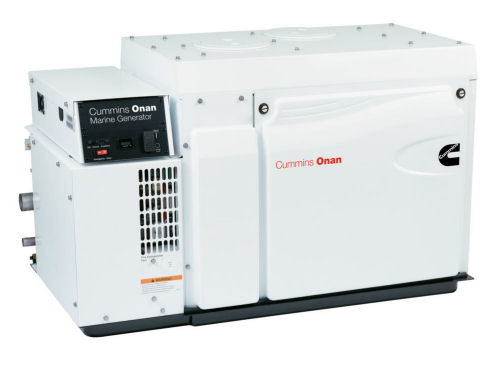
A wide choice of second generators
tailor generator size for anticipated use, which is an important consideration for boats intending to spend weeks away from shore power. Either the 13.5 kW or 17 kW options (both rated at 60 Hz) burn less fuel and operate closer to ideal load during times of low AC power use.
On the other hand, the 21.5 kW or 23 kW options can mirror the primary generator, providing complete redundancy and one common set of spare parts.
European 50 Hz generator choices are 19 kW, 13.5 kW and 11 kW.
Dual “stacked” inverters
are each able to produce 3500 watts of 120-volt power alone, are stacked to provide a continuous 7000 watts (7 kW) of AC power, and up to 10,000-watts during starting surges and 8000 watts for half an hour, without running a generator.
Included on inverter power
are all refrigerators, freezers, wine coolers and icemakers as well as the cooktop, microwave/convection oven, sink disposal, trash compactor and optional dish washer, along with anything plugged into 110-volt outlets.
That leaves for generator power only the washer, dryer, the optional oven and most air conditioners. Water is heated either by the generator or heat from a main engine.
Salon and pilothouse air conditioners
are both powered through variable frequency drives to limit startup surges, which reduced the likelihood of tripped dockside circuit breakers and eases the startup amperage demanded on the generator.
Fleming also engineered the pilothouse AC to run off the inverter alone when both main engines supply the large DC power demand.

Shore power
is taken aboard by either one or two 50-amp cords, depending on anticipated electrical load, with connections for both cords in the bow and the stern.
Charles Iso-Boost shore power transformers also eliminate most dockside improper AC wiring concerns and automatically boost shore power when volts dip too low.
Dealing with American 60 Hz to European 50 Hz conversion
becomes much simpler when most of the boat, even most AC-powered appliances, can run off of battery power. Battery chargers run on either 50 or 60 Hz dockside power.
For extended use abroad, Fleming can install a frequency converter to power the boat entirely from either 60 Hz or 50 Hz dockside power at will.
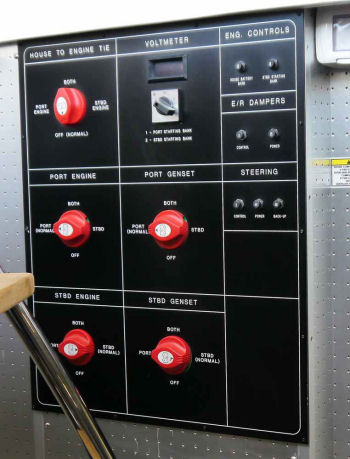
DC Power
battery banks are in triplicate, with a fourth bank high in the boat for emergency power.
Independent port and starboard start banks
, each 255 Amp-hour rated, ensure house loads aren’t drawing down generator and engine starting batteries. Each engine alternator and generator 24vdc output charge these banks.
House batteries
, rated at 900 amp-hours, handle DC lighting, appliance and inverter loads. Redundant 140-Amp alternators, one on each engine, charge the house bank.
Emergency batteries
on the flying bridge provide backup power to vital systems if the primary DC system fails from flooding or fire. They’re kept charged by a pair of 24- to 12-volt DC converters.
Battery Charging
is also accomplished by either of two battery charges powered by generators or shore power, and an optional 980-Amp solar array mounted atop the flying bridge hardtop. The inverter system can also charge batteries from generator or shore power.

Price and Options
We usually look at a boat’s standard equipment list in comparison to other boats in its class. As far as 65’ (19.8 m) motoryachts that reach planing speed go, few offer, even as options, anywhere near the standard redundancy built into the Fleming 65. Many standard features in Fleming 65 are options in other yachts in the LRC class, to say nothing of the motoryacht class.
Consumers shopping price should keep that in mind. Frankly when buying a boat of this type we don't recommend price-chopping in the first place. Rather, find the boat that can do the job required and which looks good to the nautical eye. Let price fall where it may. We know of no one who is getting rich in this business anymore.
Options for Specific Applications.
Yet even with that extensive list of included gear, Fleming still offers an exhaustive list of options. This reflects the boat’s possible capabilities, where cruising to far corners of the world requires unique preparation. Boaters planning long expeditions are also much more likely to be experienced boaters and meticulous planners, each bringing their own preferences reflected in the extensive equipment lists.
The Price.
Fleming's dealers around the world offer older boats, and option them out given the local geography, so prices for inventoried boats vary. One dealer in the U.S. told us that the base price of the boat is $3.340 million with twin 800-hp MAN engines. He also said that with all of the usual gear people put on, such as electronics, tenders, and the like, the price will be more like $3.8 million including freight and dealer prep.
Observations
Obviously this is a boat done right in every respect and built for a knowledgeable and demanding clientele -- to say nothing of demanding conditions. Possibly most important, Tony Fleming himself has spent plenty of time and tens of thousands of miles cruising this model -- something most boat builders do not have the time nor the money to do -- and has shaken out every kink he could find.
It is good to remember when contemplating a yacht of this nature and cost, customization work to suit a specific owner's needs is not an obstacle. Just ask.

